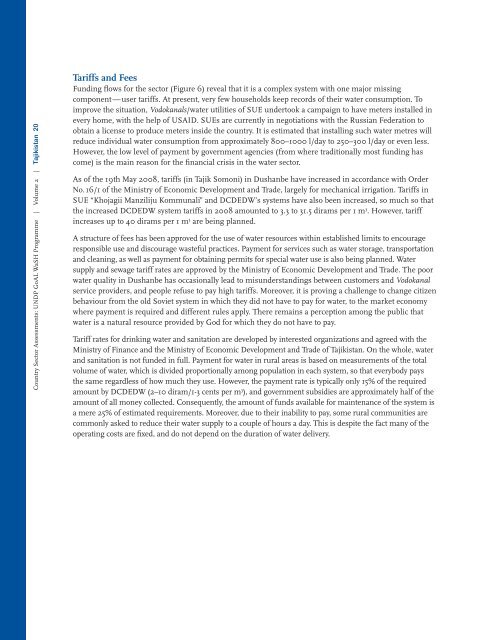Tajkistan - Water Governance Facility
Tajkistan - Water Governance Facility
Tajkistan - Water Governance Facility
Create successful ePaper yourself
Turn your PDF publications into a flip-book with our unique Google optimized e-Paper software.
Country Sector Assessments: UNDP GoAL WaSH Programme | Volume 2 | ����������� ��<br />
Tariffs and Fees<br />
Funding flows for the sector (Figure 6) reveal that it is a complex system with one major missing<br />
component — user tariffs. At present, very few households keep records of their water consumption. To<br />
improve the situation, Vodokanals/water utilities of SUE undertook a campaign to have meters installed in<br />
every home, with the help of USAID. SUEs are currently in negotiations with the Russian Federation to<br />
obtain a license to produce meters inside the country. It is estimated that installing such water metres will<br />
reduce individual water consumption from approximately 800–1000 l/day to 250–300 l/day or even less.<br />
However, the low level of payment by government agencies (from where traditionally most funding has<br />
come) is the main reason for the financial crisis in the water sector.<br />
As of the 19th May 2008, tariffs (in Tajik Somoni) in Dushanbe have increased in accordance with Order<br />
��� 16/1 of the Ministry of Economic Development and Trade, largely for mechanical irrigation. Tariffs in<br />
SUE “Khojagii Manziliju Kommunali” and DCDEDW’s systems have also been increased, so much so that<br />
the increased DCDEDW system tariffs in 2008 amounted to 3.3 to 31.5 dirams per 1 m 3 . However, tariff<br />
increases up to 40 dirams per 1 m 3 are being planned.<br />
A structure of fees has been approved for the use of water resources within established limits to encourage<br />
responsible use and discourage wasteful practices. Payment for services such as water storage, transportation<br />
and cleaning, as well as payment for obtaining permits for special water use is also being planned. <strong>Water</strong><br />
supply and sewage tariff rates are approved by the Ministry of Economic Development and Trade. The poor<br />
water quality in Dushanbe has occasionally lead to misunderstandings between customers and Vodokanal<br />
service providers, and people refuse to pay high tariffs. Moreover, it is proving a challenge to change citizen<br />
behaviour from the old Soviet system in which they did not have to pay for water, to the market economy<br />
where payment is required and different rules apply. There remains a perception among the public that<br />
water is a natural resource provided by God for which they do not have to pay.<br />
Tariff rates for drinking water and sanitation are developed by interested organizations and agreed with the<br />
Ministry of Finance and the Ministry of Economic Development and Trade of Tajikistan. On the whole, water<br />
and sanitation is not funded in full. Payment for water in rural areas is based on measurements of the total<br />
volume of water, which is divided proportionally among population in each system, so that everybody pays<br />
the same regardless of how much they use. However, the payment rate is typically only 15% of the required<br />
amount by DCDEDW (2–10 diram/1-3 cents per m 3 ), and government subsidies are approximately half of the<br />
amount of all money collected. Consequently, the amount of funds available for maintenance of the system is<br />
a mere 25% of estimated requirements. Moreover, due to their inability to pay, some rural communities are<br />
commonly asked to reduce their water supply to a couple of hours a day. This is despite the fact many of the<br />
operating costs are fixed, and do not depend on the duration of water delivery.


